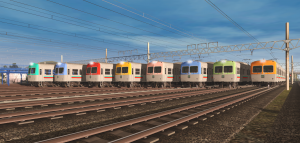
All eight Jomo Electric Railway 700 Series sets currently in service, ranging from No.1 on the left to No.8 on the right.
DOWNLOAD
All the necessary dependencies are either included in this package or are avaible on the DLS. Scripts belong to their respective owners.
(Consists are included! Don’t bother with placing individual cars!)
By the late 1990s, rolling stock on the rural Jomo Line was entirely formed of 300 and 350 Series trains, wich were hand-me down trains from Jomo Electric Railway’s major shareholder – Tobu Railway.
Specifically, these were former 3000 and 3050 Series trains, built in the 1970s but using the underframe, nose-suspended motors and other traction equipment from the 7300 Series, old electric multiple units based on the JNR 63 Series design and dating back to the post-war years.
Thus, depsite the new bodyshell (based on Tobu’s 8000 Series), the equipment of these trains was already quite worn out, after more than half-a-century of usage. Jomo Electric Railway had purchased these trains from Tobu at a preferential price to replace, almost as an emergency mesaure, the even older rolling stock that was in service until then on the line: essentially a ragtag mix of various EMU designs, including ex-Seibu trains, some of wich dated back to the 1930s!
However, after half a decade of usage on the Jomo Line, it was already well clear that the 300 and 350 Series trains were well beyond their lifespan, and that the company couldn’t expect to keep them in service for much longer – a more “definitive” replacement was thus needed.
This replacement came in the form of 3000 Series trains from the Keio Inokashira Line – built in the early 1960s as one of the very first mass-produced stainless-steel-bodied train serieses in Japan, the 3000 Series was then just starting to be replaced by the newer 1000 Series on the busiest Inokashira Line duties. However, depsite being roughly 30 years old, the 3000 Series trains were in perfect working condition, and had all been fitted with air-conditioning in the mid-1970s.
Thus, sensing the bargain, Jomo Electric Railway proceeded to purchase (with the help of subsidies from local governments) sixteen cab cars to be reformed into eight 2-car sets, more than enough to cover all services operating on the Jomo Line. The purchased cars were rebuilt, modified and adapted to one-man operation by Keio Railway’s Keio Heavy Industries subsidiary company, using equipment such as the master controller, salvaged off from Keio’s 5000 Series and spare parts from the Toei Subway 6000 Series trains, wich were undergoing air-conditioning retrofitting at the company’s workshop at the same time.
All eight trains were introduced and entered regular revenue services in 1998, replacing the most worn-out 300 and 350 Series trains immediately (altough some 350 Series sets were retained as spares up until 2000).
Initially painted in the same livery – violet upper front portion and acqua green and red side bands – starting from 2009, each of the eight sets began to have it’s upper front portion painted in an unique colour, an hommage to Keio Railway’s practice that had been introduced by these trains, altough with slightly different colours.
Currently, all eight 700 Series sets handle the entirety of regular passenger traffic on the Jomo Line – no “heavy” modifications have been performed on these trains in about 20 years of service (save from the replacement of wipers and compressors on some sets). However, age is catching up to them as well – with most sets now about half-a-century old too (30 years of wich spent on the Inokashira Line and the remaining 20 spent on the Jomo Electric Railway), equipment is ageing, and a replacement is now needed again.
Originally, Jomo Electric Railway planned to introduce a newly-built electric railcar (likely similar in concept to Ichibata Electric Railway’s 7000 Series, wich would’ve been the company first new piece of rolling stock since it’s establishment in 1926, a century earlier!) using government subsidies. However, these plans were quickly shelved due to high costs, with the company opting instead for the purchase of “new” second-hand trains, with Tokyo Metro being singled out as the likely source; however, nothing official has been announced yet, and it’s very likely that the 700 Series will continue to trudle up and down the Jomo Line for atleast a decade to come.
